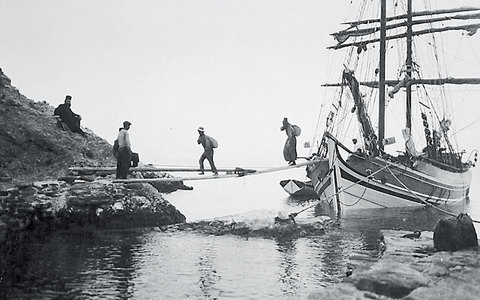Monastery of Esphigmenou in 1918, picture: www.ethnos.gr
"Storm" mine-layer landed on November 2, 1912 in Karies of Mount Athos and George Papageorgiou fixed the Greek flag on the territory of the Monastic Republic, thus bringing the freedom notice.
Little is known about what happened to Athos during the years of Ottoman rule, mostly because of the scarcity of sources. Throughout the month, Mount Athos Municipality in Thessaloniki will organise a variety of events dedicated to this period, under the motto "The Liberation of Mount Athos". An international conference with two round tables, a photographic exhibition, a jubilee volume, a facsimile reprint of a rare English book are just some of the events.
Director of the Institute for Historical Research Kriton Chrysohoidis said that the ambition is to fill the gaps in knowledge about what happened during this period. Ottoman rule lasted half a millennium, and in its first 30 years it caused much destruction to Mount Athos. Later, the Sultan's army withdrew and only the kaimakam, who collected taxes, remained. Up to the time of the liberation, life on Mount Athos went on quietly, without excesses, without violence, but in decline, as noted by Dimitris Salpistis of the Municipality of Mount Athos. Monks were able to perform their religious duties without any problems. They could work the land, providing much of the crop to the Turks, they were able to come out of Mount Athos, and the last kaimakam, Ali Talat-Mounlazade, maintained friendly relations with a lot of monks. At the press conference, Thessaloniki Mayor Yiannis Boutaris, who is also Mount Athos Municipality's Chairman, told the journalists that since the late 19th century, on the initiative of monk librarians, in collaboration with Greek and foreign researchers, a description of Athonite archives has begun. These archives contain valuable information about the spiritual and cultural heritage of the Holy Mountain. After the liberation, Mount Athos flourished. The monastery complex was expanded, new chapels were erected. A lot of artists were attracted by this place, creators of marble items, wooden sculptures, copper engravings, book-binders, and in parallel, educated Athonite monks were dealing with the history of the place.

"Thessaloniki and Mount Athos at the Dawn of the 20th Century" is the theme of the photographic exhibition of 120 photographs of Mount Athos and Thessaloniki from the archives of Greek, French and Russian institutions. They include works by Fred Boissonnas, Russian pilgrim Byzantologist Nicodemos Kondakov, inspirer of the Byzantine Museum George Lambrakis and photos from the album, given by the monastery of Saint Panteleimon to the Grand Duke Konstantin Romanov. In the spring of 2013, the exhibition will be transferred to the Serbian Cultural Centre in Paris, and at the end of next year, to the Museum of History and Religion in St. Petersburg.
The International Congress of Mount Athos Municipality is dedicated to Mount Athos in the years of the liberation and includes two round tables. It will be released as part of the series dedicated to Athos, and of the book by British explorer Atelstan Riley "Athos or the Mountain of the Monks", published in 1887 and containing exclusive lithographs and texts.